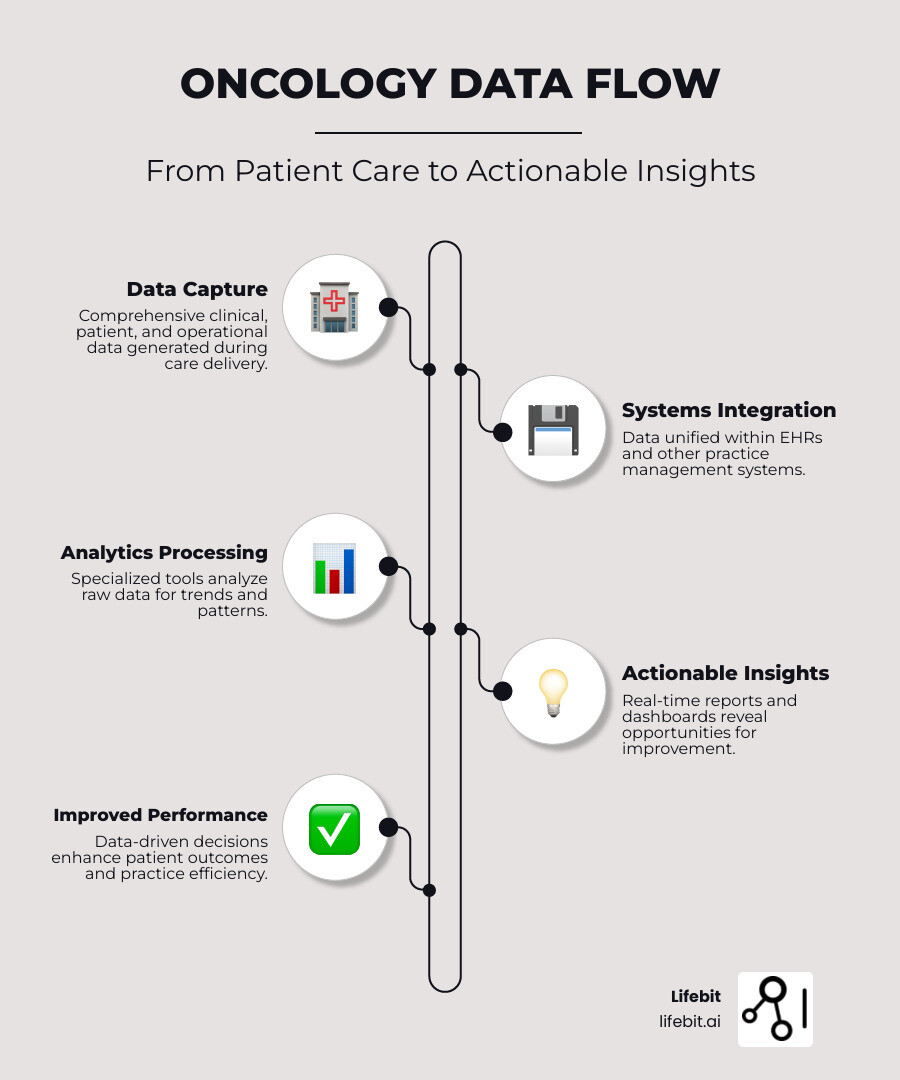Navigating Oncology Pathways: Analytics Software You Need to Know

Oncology Practice Performance Analytics Tool: Optimize 2025
Why Modern Oncology Practices Need Data-Driven Decision Making
An oncology practice performance analytics tool is software that transforms clinical, financial, and operational data into actionable insights. These insights help improve patient outcomes, optimize revenue cycles, and boost practice efficiency. Such tools are essential for oncology practices navigating the complex transition to value-based care models.
The oncology landscape has become increasingly complex. Practices struggle to balance quality care delivery with regulatory requirements and financial pressures. Modern analytics tools address this challenge by automating quality measure reporting, which can save hundreds of hours per practice annually. They also identify revenue recovery opportunities and provide real-time insights into clinical pathways and patient outcomes.
I’m Dr. Maria Chatzou Dunford, CEO and Co-founder of Lifebit, where I’ve spent over 15 years developing computational biology and AI solutions that power precision medicine through federated data analysis. My experience building cutting-edge genomics tools and biomedical data platforms has given me deep insights into how an oncology practice performance analytics tool can transform healthcare delivery across secure, compliant environments.

Oncology practice performance analytics tool terms to know:
The Clinical and Patient Impact of Oncology Analytics
The primary goal of any healthcare practice is to deliver exceptional patient care. For oncology practices, where the stakes are incredibly high, the ability to leverage data for clinical quality improvement, patient safety, and personalized treatment is paramount. An oncology practice performance analytics tool serves as the backbone for achieving these critical objectives.
These tools empower us to deliver high-quality, cost-effective care by providing actionable insights. By adopting advanced technology, practices can improve patient safety, monitor performance for continuous improvement, and ensure every clinical decision is supported by the latest evidence. Some practices have achieved near-perfect diagnosis code accuracy after implementing analytics, directly improving billing and patient care records.
Furthermore, these platforms support evidence-based medicine by integrating with established guidelines, such as the NCCN Clinical Practice Guidelines in Oncology. They can incorporate value pathways to refine treatment decisions based on efficacy, toxicity, and financial impact.
The focus on patient-reported outcomes (PROs) is also significantly improved by analytics tools. Leading solutions support PRO measures, including tracking the resolution of identified health-related social needs (HRSNs). Beyond direct clinical benefits, these tools facilitate better outcomes by identifying patients eligible for clinical trials, expanding their treatment options. For more on how data analysis drives patient outcomes, explore our insights on Patient Outcomes: Oncology Data Analysis.
Enhancing Treatment Efficacy and Safety
An oncology practice performance analytics tool is instrumental in ensuring treatments are both effective and safe. These tools improve care by promoting adherence to evidence-based clinical pathways, providing regimen support with cost and efficacy data at the point of care, integrating precision medicine modules for personalized treatment, and offering real-time clinical alerts for potential safety issues like drug interactions or patient deterioration.
Improving the Patient Experience
A positive patient experience is a cornerstone of quality care, and oncology practice performance analytics tools contribute significantly. They help by facilitating secure patient portal access to clinical information, reducing wait times through patient flow analysis, enabling proactive communication via secure messaging and care plans, and tracking patient engagement with educational materials to improve communication strategies.
Financial and Operational Advantages of an Oncology Practice Performance Analytics Tool

Oncology practices face intense financial pressures from rising drug costs, complex reimbursement models, and regulatory demands. An oncology practice performance analytics tool serves as a financial lifeline by improving revenue cycle management through deep insights into reimbursements, faster prior authorizations, and correct claim coding. It helps find claims paid below cost and identifies billing errors that would otherwise go unnoticed. Cost reduction is achieved with clear visibility into expenditures, particularly through optimized inventory management for expensive oncology drugs. The gains in operational efficiency are also impressive, as automating manual report generation frees up staff for patient-facing activities and strengthens a practice’s position in payer contract negotiations with hard data on operations, care costs, and outcomes.
The Role of an Oncology Practice Performance Analytics Tool in Value-Based Care
The healthcare landscape has shifted dramatically toward value-based care models, and oncology practices can’t afford to be left behind. An oncology practice performance analytics tool isn’t just helpful for navigating MIPS and OCM requirements – it’s absolutely essential.
MIPS reporting becomes more manageable with platforms that have earned CMS designation as a Qualified Clinical Data Registry (QCDR). These allow practices to report meaningful, oncology-specific quality measures directly, eliminating the manual effort of compliance.
Quality measure tracking is automated for a comprehensive set of metrics, including patient-reported outcomes, advance care planning, and appropriate therapy use. Cost-effectiveness analysis can happen in real-time, with tools providing clinical and financial information at the point of care.
Common oncology-specific QCDR measures supported by leading analytics tools include measures such as Advance Care Planning in Metastatic Cancer Patients, Patient-Reported Pain Improvement, Supportive Care Drug Utilization, and Mutation Testing for Stage IV Lung Cancer, among others.
For deeper insights into how real-world evidence optimization supports these efforts, explore Optimizing Real-World Evidence in Pharma.
Optimizing Practice Operations and Financial Health
The day-to-day financial health of a practice depends on countless details, and an oncology practice performance analytics tool helps manage them while revealing major improvement opportunities. For example, precise inventory management tracks expensive drugs in real-time, while claims denial analysis transforms reactive damage control into proactive revenue protection by uncovering coding errors before they become denials. Simultaneously, staffing level benchmarking provides objective data for workforce planning, and patient flow analysis reveals bottlenecks and optimization opportunities throughout the practice.
The financial impact can be transformative. Some practices have achieved near 100% diagnosis code accuracy, eliminating errors that previously impacted billing and clinical data integrity.
| Metric | Manual Reporting | Automated Reporting |
|---|---|---|
| MIPS Submission Time | Labor-intensive, multiple staff, weeks | Streamlined, automated, hours |
| Diagnosis Code Accuracy | Prone to error, delayed corrections | Near 100% accuracy, real-time verification |
| Charge Capture | Missed charges, reconciliation issues | Identified non-exported charges, timely resolution |
| Inventory Reconciliation | Time-consuming, potential for waste | Real-time tracking, optimized ordering |
| Payer Contract Negotiation | Based on historical data, limited leverage | Data-driven insights, stronger position |
| Staff Productivity Benchmarking | Anecdotal, difficult to compare | Quantifiable metrics, peer comparison |
Core Functionalities and Key Modules to Look For
When selecting an oncology practice performance analytics tool, think of it as a central nervous system for your practice, not just another piece of software. The best platforms function as comprehensive ecosystems, pulling data from disparate sources like your Electronic Health Record (EHR) and practice management systems to eliminate data silos and create a single source of truth.
The core of this functionality is seamless EHR interoperability. This is the mechanism that automatically pulls clinical, financial, and operational data into one unified view, saving countless hours of manual data entry and reducing errors. From there, customizable dashboards are essential. They allow different team members—from clinicians to administrators to billers—to see the specific metrics and insights relevant to their roles, ensuring the data is not just available but actionable.
Other critical functionalities include real-time reporting, which ensures decisions are based on the most current information, and benchmarking capabilities, which allow you to measure your practice’s performance against regional and national peers. Finally, data security must be foundational. Look for platforms with robust, built-in security protocols that guarantee HIPAA compliance and protect sensitive patient data at every step. For deeper insights into how analytics transforms oncology data into actionable intelligence, explore our comprehensive guide on Oncology Data Analytics.
Clinical Decision Support and Quality Reporting

Clinical decision support modules in your oncology practice performance analytics tool act as a knowledgeable digital colleague, helping ensure every treatment decision is backed by solid evidence. They provide evidence-based treatment suggestions at the point of care, often based on NCCN guidelines and value pathways, while clinical pathway compliance monitoring helps maintain consistency across your practice.
A significant time-saver is automated quality measure abstraction. Instead of having staff manually pull data, leading platforms handle this automatically, saving hundreds of hours annually by electronically submitting measure scores for quality certification programs. Furthermore, dedicated MIPS and QCDR modules take the headache out of regulatory reporting. Leading tools support numerous oncology-specific QCDR measures, handling the complex submission process directly to CMS and enabling peer benchmarking through quality programs to create a culture of continuous improvement.
Financial and Revenue Cycle Analytics
The financial modules of your analytics tool are like a detective for your practice’s bottom line. Buy-and-bill analysis is crucial, identifying claims where drug reimbursement fell below cost and providing data to recover losses. The tool also flags any other underpaid claim. Detailed accounts receivable aging reports help prioritize collection efforts, while payer performance dashboards clarify how different insurers handle claims. This data, combined with drug cost and reimbursement analysis, aids in both financial planning and patient counseling.
Operational and Strategic Planning Modules
Operational modules in your oncology practice performance analytics tool optimize daily workflows and inform long-term growth. Patient scheduling and wait time analysis reveals operational bottlenecks, while chair utilization reports are essential for managing infusion center investments. The tool provides objective staff productivity metrics for workload balancing and uses referral source tracking and market assessment capabilities to guide practice growth and expansion. For more insights into how health data can be prepared for research and strategic planning, explore our resource on Creating Research-Ready Health Data.
The Future: AI, Machine Learning, and Real-World Data in Oncology Analytics
The next chapter for oncology practice performance analytics tools is being written by groundbreaking technologies that are changing how we understand and improve cancer care. We’re moving from looking backward at what happened to predicting what’s coming next—and that shift is revolutionary.
Predictive analytics powered by AI and machine learning are already changing the game. These smart systems can analyze years of historical data to forecast everything from which patients might miss their appointments to when your infusion equipment needs maintenance. Imagine knowing ahead of time which treatment protocols are most likely to succeed for specific patient populations, or being able to predict staffing needs based on seasonal patterns.
AI-powered insights can spot patterns humans simply can’t see. For example, AI has been used to analyze millions of unstructured documents many times faster than traditional methods, opening up insights that can improve patient care.
Real-world data integration is another game-changer. While clinical trials give us controlled environments, real-world data from EHRs, claims, and patient registries shows us what actually happens in everyday practice. An oncology practice performance analytics tool that harnesses this information provides a complete picture of patient journeys, treatment effectiveness in the real world, and population health trends.
Perhaps most exciting is how we’re finally cracking the code on unstructured data analysis. Think about all the valuable insights locked away in physician notes, pathology reports, and clinical narratives. Advanced Natural Language Processing can now extract meaningful information from these documents, turning previously unusable text into actionable data points.
Federated learning represents the cutting edge of secure, collaborative analytics. This approach allows AI models to learn from data across multiple practices without that sensitive information ever leaving its secure home environment. It’s like having a brilliant consultant who can learn from every practice’s experience while respecting each one’s privacy and data sovereignty.
The future we’re building isn’t just about better reports—it’s about machine learning models that continuously improve care delivery, reduce costs, and improve patient outcomes. For deeper insights into how AI is revolutionizing biomarker findy in oncology, explore our work on AI-Powered Biomarker Findy.
These advances are changing oncology analytics from a reactive tool into a proactive partner in delivering exceptional cancer care.
How to Choose the Right Oncology Analytics Solution
Choosing the right oncology practice performance analytics tool feels a bit like finding the perfect treatment protocol – it needs to fit your specific situation perfectly. The stakes are high, and the wrong choice can impact everything from patient care to your bottom line.
Start with a thorough needs assessment. Are you drowning in MIPS reporting requirements? Struggling with revenue cycle issues? Looking to improve clinical outcomes? Be brutally honest about your biggest pain points. A practice focused on improving patient flow will have very different needs than one primarily concerned with payer contract negotiations.
Scalability is crucial, especially in today’s rapidly evolving healthcare landscape. Your perfect solution today should still serve you well as your practice grows. Whether you’re planning to add providers, expand locations, or increase patient volume, the platform should adapt without requiring a complete overhaul in two years.
Don’t underestimate the importance of vendor support and training. The most sophisticated analytics tool becomes useless if your staff can’t use it effectively. Look for vendors who offer comprehensive training programs and responsive customer service.
Customization options can make or break your experience. While pre-built dashboards are helpful starting points, your practice has unique workflows and priorities. The ability to customize reports, dashboards, and key performance indicators to match your specific environment is invaluable.
Data integration capabilities are absolutely critical. Your new analytics tool needs to play nicely with your existing EHR and practice management systems. Poor integration creates data silos that defeat the entire purpose of having an analytics platform.
Finally, security and compliance cannot be an afterthought. Patient data protection is paramount, especially in oncology where sensitive information abounds. Verify that vendors adhere to strict security standards like HIPAA compliance and have robust protocols for data privacy and access controls. For insights into comprehensive health data analysis platforms that prioritize security, explore our discussion on Health Data Analysis Platforms for All.
Evaluating an Oncology Practice Performance Analytics Tool for Your Needs
Once you’ve narrowed down your options, it’s time for the real evaluation work. Think of this phase as your clinical trial – you need solid data to make the right decision.
Define your key performance indicators (KPIs) before any vendor walks through your door. What metrics actually matter to your practice? New patient visits per month? Revenue per patient encounter? Chemotherapy chair utilization rates? MIPS scores? Having these clearly defined helps you assess whether each tool can effectively track and report on what matters most to you.
Assess interoperability with your existing systems thoroughly. Don’t just accept vendor assurances – dig deeper. Ask about specific integration methods, data mapping processes, and any potential limitations with your current EHR or practice management system.
Request live demonstrations that go beyond the standard sales pitch. Ask to see realistic scenarios that mirror your daily workflows. Can the system handle your typical patient volume? How quickly can you generate the reports you need most? Pay close attention to the user interface – if it feels clunky during a polished demo, imagine using it under real-world pressure.
Evaluate reporting and dashboard customization during these demos. Ask to see how custom reports are built and how dashboards can be personalized. Does creating a new report require a computer science degree, or can your office manager handle it?
Inquire thoroughly about implementation and support services. Understanding the typical implementation timeline, required resources from your team, and ongoing support model is crucial. What kind of training is provided? How responsive is technical support?
This isn’t just a software purchase – it’s an investment in your practice’s future. Take the time to evaluate thoroughly, and don’t rush the decision.
Conclusion
The modern oncology practice operates in an increasingly complex world where every decision matters. From managing expensive drug inventories to meeting stringent quality measures, practices face pressures that would have been unimaginable just a decade ago. An oncology practice performance analytics tool has evolved from a “nice-to-have” technology into the essential infrastructure that keeps practices thriving.
Throughout this guide, we’ve seen how these tools fundamentally transform oncology care delivery. They turn overwhelming data streams into clear insights that improve patient outcomes—whether that’s identifying the right clinical trial for a patient, ensuring proper antiemetic therapy, or catching potential safety issues before they become problems. The clinical impact is profound: practices can achieve near-perfect diagnosis code accuracy, save hundreds of hours annually on regulatory reporting, and deliver more personalized, evidence-based care.
The operational benefits are equally compelling. These platforms streamline workflows that once consumed countless staff hours, optimize resource allocation in ways that directly impact the bottom line, and provide the data foundation needed for successful value-based care participation.
Looking ahead, the integration of AI and machine learning promises even more exciting possibilities. The ability to analyze millions of unstructured documents rapidly opens doors to insights we’re only beginning to imagine. Predictive analytics will help practices anticipate patient needs, optimize staffing, and even predict treatment responses with greater accuracy.
Data has become the most strategic asset for oncology practices, but accessing its full potential requires sophisticated, secure platforms that can handle the complexity of modern healthcare. The future belongs to practices that can harness federated learning, real-world evidence, and AI-powered insights while maintaining the highest standards of data security and patient privacy.
At Lifebit, we understand that every piece of oncology data represents a human story—a patient hoping for better outcomes, a family seeking answers, a practice striving to deliver exceptional care. Our next-generation federated AI platform enables secure, real-time access to global biomedical and multi-omic data, with built-in capabilities for harmonization, advanced AI/ML analytics, and federated governance. Through components like our Trusted Research Environment (TRE), Trusted Data Lakehouse (TDL), and R.E.A.L. (Real-time Evidence & Analytics Layer), we deliver real-time insights, AI-driven safety surveillance, and secure collaboration across hybrid data ecosystems.
We believe every oncology practice deserves the power to transform their data into better patient outcomes and a more sustainable future. Because at the end of the day, that’s what this is all about—giving practices the tools they need to focus on what matters most: healing.


